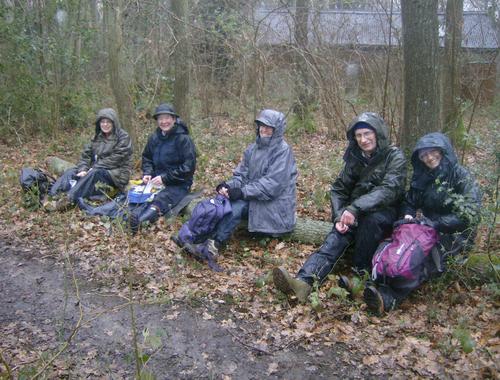Worcestershire Bryophyte Group 2012
Ann Hill
This has been a busy year for Worcestershire bryophyte recording. During 2012 Worcestershire Bryophyte Group had several successful field recording days at five Worcestershire sites. The group recorded a total of 283 bryophytes (105 species: 11 liverworts and 94 mosses) in a variety of habitats. Five pleurocarpous mosses, Brachythecium rutabulum, Hypnum cupressiforme var. cupressiforme, Kindbergia praelonga and Rhynchostegium confertum and the liverwort Lophocolea bidentata, were ubiquitous and were recorded at every site visited. Another seven species, Amblystegium serpens var. serpens, Barbula unguiculata, Dicranoweisia cirrata, Fissidens taxifolius var. taxifolius, Orthotrichum affine, O. diaphanum and Rhytidiadelphus squarrosus, were recorded in four out of the five sites visited. A summary of the five sites visited and their bryophyte interest is given below.
The Knapp and Papermill (visited 18/02/12). We recorded 42 bryophytes (7 liverworts and 35 mosses) which, considering the atrocious weather conditions, and shortened recording day, was very good. Five bryophytes were a new record for the site: Acaulon muticum was recorded on an ant hill in Papermill Meadow (there are only four county records to date); Brachytheciastrum velutinum was found growing on soil covered rock along the main track; Dicranum scoparium was noted on the ground in the woodland; Didymodon fallax was growing on disturbed ground beside the track; and Pohlia wahlenbergii var. wahlenbergii was recorded in Papermill Meadow. We have now visited The Knapp and Papermill on four occasions and the total number of bryophytes recorded is 95 (17 liverworts and 78 mosses) which is an amazing record for one site and proves the value of re-visiting an area.
Northwick Marshes Site of Special Scientific Interest and Northwick Lido (visited 11/03/12). This was a joint field trip with the Border Bryologists. It was a glorious day for both weather and bryophytes and we recorded 65 species (4 liverworts and 61 mosses). The list included many bryophytes that we do not normally collect because we of the expertise of Mark Lawley and also because we were recording in a different habitat to our usual excursions. No rarities were found but Bryum violaceum, Cinclidotus fontinaloides, Ditrichum heteromallum, Entosthodon fascicularis, Hennediella stanfordensis, Orthotrichum sprucei and Scleropodium cespitans were interesting and valuable records for VC37.
Monkwood (visited 21/04/12). We recorded 31 bryophytes (5 liverworts and 26 mosses). This was not a large list but an interesting record. Species of note were Cryphaea heteromalla, Dicranella staphylina, Dicranum tauricum, Orthotrichum stramineum, Ulota phyllantha and Radula complanata. All are common species that are undoubtedly under recorded in the county.
The Devil’s Spittleful and Rifle Range (visited 22/09/12). We recorded 28 bryophytes (1 liverwort and 27 mosses) of which the majority were typical heathland mosses; overall the site was disappointing for bryophytes. The most interesting record was of Pseudoephemerum nitidum, an ephemeral moss that was recorded on the site of a bonfire. Pseudoephemerum nitidum is of frequent to common abundance throughout England but we have only five records to date in VC37 so this was an excellent find. In addition, the moss Campylopus fragilis formed dense tufts on crag ledges associated with the Devil’s Spittleful. There are only two records of Campylopus fragilis in VC37: one in the Wyre Forest and one at Broad Down, Malvern. One of our commonest and most cosmopolitan mosses, Ceratodon purpureus, was widely distributed across the site on acidic, well-drained sandy soil. Due to the absence of the usually abundant capsules, we confused this common moss with a number of acrocarpous mosses with triangular leaves and recurved margins before we correctly identified it.
Droitwich Community Woods (visited 13/10/12). We recorded 32 bryophytes (5 liverworts and 27 mosses) and the species list was one of the most interesting to date. The notable species was Syntrichia papillosa which was found growing on the bark of an ash. This species is infrequent throughout Britain and Ireland, but may be spreading. It is particularly associated with urban street trees and is often abundant on tree trunks in western towns. Syntrichia papillosa has only been recorded twice before in VC37: both occasions were in 2004 during the British Bryological Society meeting to the county.
For anyone wishing to discover a bit more about bryophytes, the following field days are planned and people are welcome to join us (although please email me ann@hillsecology.co.uk prior to the day to advise that you will be joining us).
Ravenshill Wood Nature Reserve, Alfrick - Saturday 24th November 2012
Worcestershire Wildlife Trust, Smite - Saturday 26th January 2013
Malvern Hills Castlemorton Common – Joint day with Border Bryologists – Sunday 17th March 2013
An Invitation to YOU
We are a small informal group (this year between five and eleven active participants) that visit Worcestershire sites to record and learn about bryophytes. Our broad aim is to assist everyone, especially those who are new to mosses and liverworts, to become more experienced and confident at identifying bryophytes. We have no formal membership or constitution and each person goes out at his/her own risk. Beginners are always very welcome, the only equipment needed is a hand lens (x10 or x20) and some paper packets for collecting specimens. In the field, the group will often work through the keys in the British Bryological Society’s Mosses and Liverworts of Britain and Ireland: a Field-guide (2010). Whilst we usually spend the morning concentrating on bryophyte identification, during the afternoon our attention tends to wander towards more general natural history, dependent on the interests of the individuals present on the day. Some people stay all day whilst some people leave at midday.
Please contact me for further details. ann@hillsecology.co.uk
Images
Fig. 1. Worcestershire bryophyte group.
